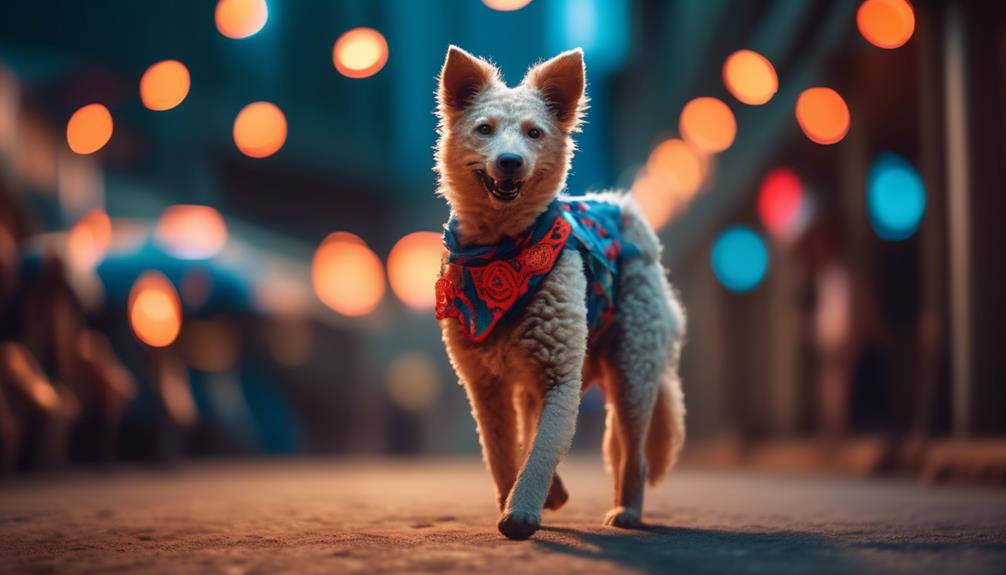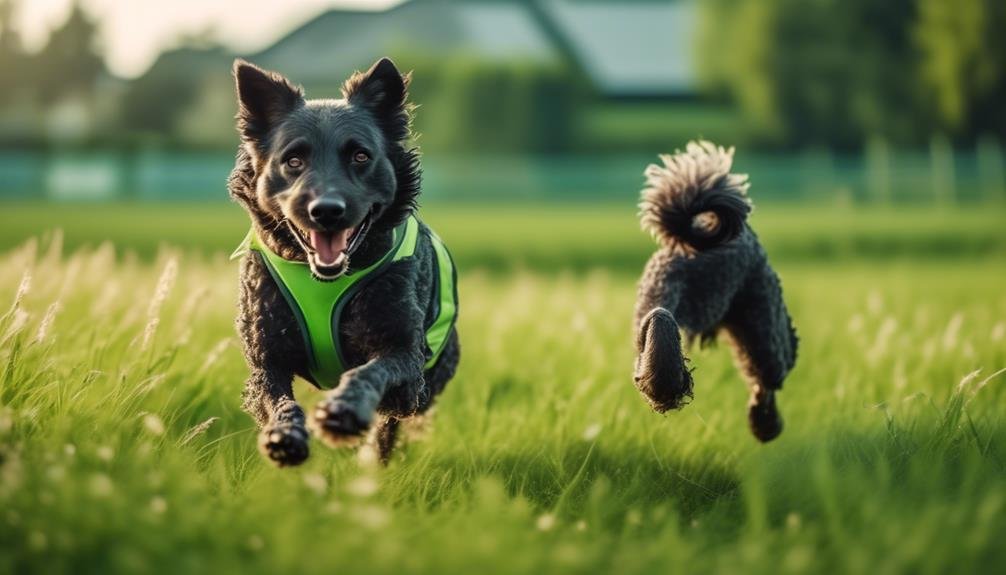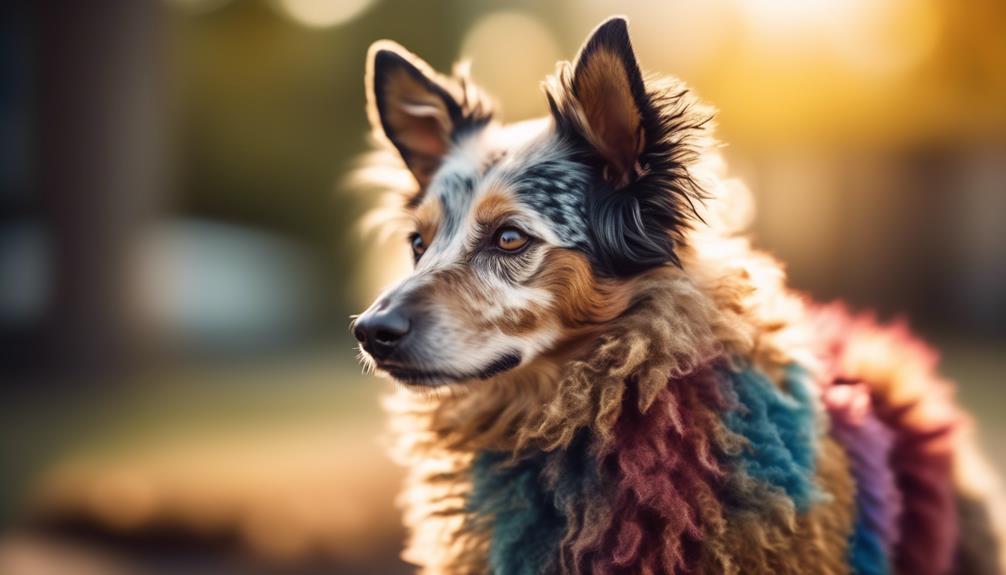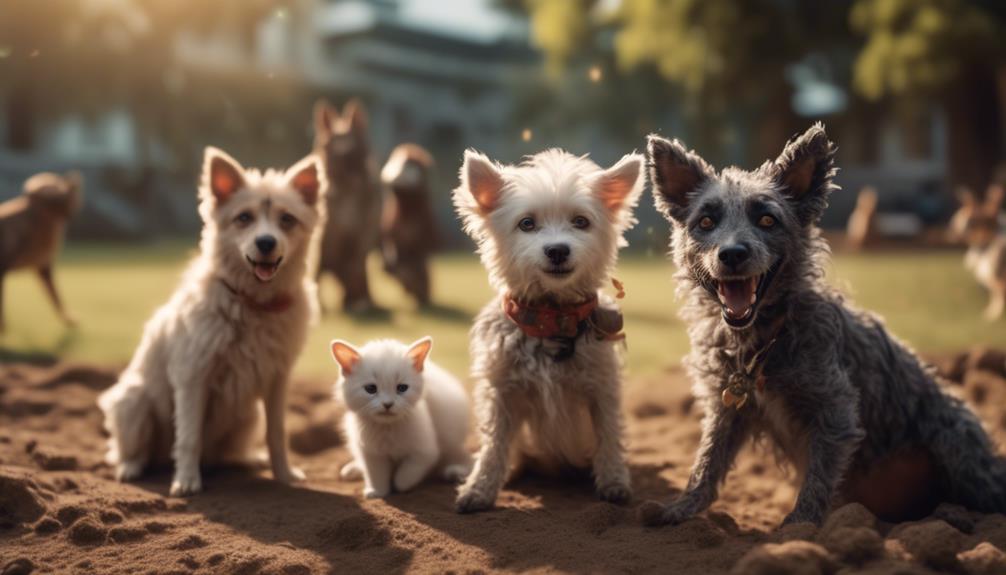With their intelligent and eager-to-please nature, Mudis have become increasingly popular as companions for active individuals or families.
But did you know that this medium-sized herding breed almost faced extinction during World War II? Despite this, Mudis have made a remarkable comeback and are now recognized by kennel clubs worldwide.
If you're curious to learn more about the characteristics and unique qualities of the Mudi dog breed, this discussion will provide you with valuable insights that may surprise you.
Key Takeaways
- The Mudi breed originated in Hungary and almost went extinct during World War II but was recognized by kennel clubs in the mid-20th century.
- Mudis are intelligent, eager to please, and easily trainable, making them excellent watchdogs.
- They have high energy levels and require significant exercise and mental stimulation.
- Mudis have a medium-length, wavy or curly coat in various colors and require minimal grooming.
Origin and History
The Mudi dog breed originated in Hungary and has a rich history that dates back to the 1930s. Discovered by Dr. Dezso Fenyes in 1936, the breed almost faced extinction during World War II. However, it was recognized by various kennel clubs in the mid-20th century, helping to revive its population.
The Mudi is a medium-sized herding dog known for its intelligence, alertness, and eagerness to please. With a lifespan of 12-15 years, the Mudi has a medium-length, double coat that comes in various colors, including black, white, brown, and fawn.
Despite its history of being a herding dog, the Mudi is also an excellent watchdog and makes a loyal companion.
Personality and Temperament

Eager to please and highly intelligent, the Mudi dog breed exhibits a lively and alert personality. They're known for their trainability and make excellent watchdogs.
Here are five key aspects of the Mudi's personality and temperament:
- Loyal companions: Mudis are affectionate with their families and known for their unconditional love and loyalty.
- Proper socialization: It's important to socialize Mudis from a young age to ensure they get along well with children and other animals. Supervision is necessary when children play with Mudis to prevent any rough treatment.
- Wariness of strangers: Mudis may be wary of strangers, but with proper training, they can learn to get along with other pets and be more accepting of unfamiliar faces.
- High energy levels: Mudis are high-energy dogs that require significant exercise and mental stimulation. They're always ready for action and thrive with an active lifestyle.
- Alertness: With their lively personality, Mudis are highly alert and make excellent watchdogs, often being quick to sound the alarm when something is amiss.
Exercise and Health Needs

With their high energy levels and need for regular exercise, it is important to address the exercise and health needs of the Mudi dog breed. Mudis are known for their active and lively nature, requiring significant physical activity to keep them mentally and physically stimulated. A well-exercised Mudi is a happy and well-behaved companion. In terms of health, Mudis have a genetic predisposition to certain conditions such as hip dysplasia, elbow dysplasia, luxating patellas, cataracts, and epilepsy. Regular veterinary check-ups and proper nutrition are crucial for their overall well-being. Below is a table summarizing the exercise and health needs of the Mudi breed:
| Exercise Needs | Health Needs |
|---|---|
| High-energy | Regular veterinary check-ups |
| Requires exercise | Genetic predispositions |
| Mental stimulation | Hip dysplasia |
| Active and lively | Elbow dysplasia |
| Well-exercised Mudi | Luxating patellas |
| Cataracts | |
| Epilepsy |
Coat Color and Grooming

Coat color and grooming requirements play a significant role in the care of the Mudi dog breed. The Mudi has a medium-length, double coat that comes in a variety of colors, including black, white, brown, and fawn.
Grooming the Mudi is relatively low maintenance, with minimal grooming required. Here are some key points to know about the Mudi's coat color and grooming:
- Medium-length, double coat
- Variety of colors, including black, white, brown, and fawn
- Regular brushing to remove loose hair and prevent matting
- Occasional baths to keep the coat clean and healthy
- Regular nail trims, teeth brushing, and ear checks for overall health and hygiene
Adaptability and Compatibility

The Mudi dog breed demonstrates adaptability and compatibility with various living situations. While Mudis can adapt well to apartment living, size alone shouldn't be the sole determinant for suitability. Factors such as energy levels and behavior towards neighbors should also be considered.
Some small dogs may have high energy and frequent barking, making them less suitable for apartments. Desirable qualities in an apartment dog include being quiet, low-energy, and polite towards other residents. When choosing a dog for an apartment, it's important to prioritize qualities such as being quiet, low-energy, and exhibiting good manners.
Additionally, proper socialization is crucial for Mudis to get along with children and other animals. Supervision is necessary when children play with Mudis, as they may not tolerate teasing or rough treatment. With proper training, Mudis can also learn to get along with other pets.
Frequently Asked Questions
Are Mudis Good With Children and Other Pets?
Mudis are generally good with children and other pets. Proper socialization is important for them to get along well. They may not tolerate teasing or rough treatment, so supervision is necessary during playtime.
How Often Should I Groom a Mudi?
Mudis should be groomed regularly to maintain their medium-length, wavy or curly coat. The frequency of grooming depends on the individual dog and their specific coat needs, but generally, a thorough brushing once or twice a week should suffice.
What Kind of Training Is Best for a Mudi?
Positive reinforcement training is recommended for Mudis. They respond well to rewards, praise, and consistency. Training should focus on obedience, socialization, and mental stimulation. Daily exercise and mental challenges are essential for their intelligent and energetic nature.
How Much Exercise Does a Mudi Need on a Daily Basis?
Mudis need a significant amount of exercise on a daily basis. They are high-energy dogs that require both physical activity and mental stimulation to stay happy and healthy.
What Is the Average Lifespan of a Mudi?
The average lifespan of a Mudi is 12-15 years. They are known for their loyalty and unconditional love towards their family. Regular vet visits and proper feeding are important for their overall health and well-being.
What Are the Similarities and Differences Between the Mudi and Norwegian Elkhound Dog Breeds?
The Mudi and Norwegian Elkhound breed share similar characteristics as medium-sized, energetic, and intelligent dogs. However, the Mudi is a herding dog from Hungary, while the Norwegian Elkhound is a hunting dog from Norway. For more Norwegian Elkhound characteristics information, it’s important to understand their history and temperament.
Conclusion
In conclusion, the Mudi dog breed is a versatile and intelligent companion that excels in herding and watchdog duties. With their alertness and trainability, they make great pets for active individuals or families.
While Mudis may be reserved with strangers, they're loyal and dedicated to their families. It's important to provide them with regular exercise and be aware of their genetic predisposition to certain health conditions.
Overall, the Mudi breed is a fascinating and unique addition to any home.




